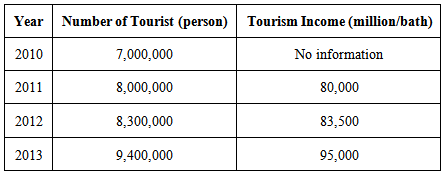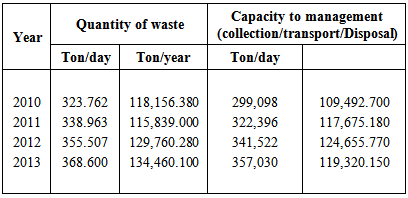-
Paper Information
- Next Paper
- Previous Paper
- Paper Submission
-
Journal Information
- About This Journal
- Editorial Board
- Current Issue
- Archive
- Author Guidelines
- Contact Us
International Journal of Applied Sociology
p-ISSN: 2169-9704 e-ISSN: 2169-9739
2015; 5(1): 5-15
doi:10.5923/j.ijas.20150501.02
Public Service Management in Local Government, Thailand (Case Study of Solid Waste Management in Pattaya City)
Anurat Anantanatorn1, Samrit Yossomsakdi2, Andy Fefta Wijaya3, Siti Rochma3
1Doctoral Program of Public Administration, Faculty of Administrative Science, University of Brawijaya, Indonesia
2Department of Public Administration, Faculty of Political Science and Law, Burapha University, Thailand
3Department of Public Administration, Faculty of Administrative Science, University of Brawijaya, Indonesia
Correspondence to: Anurat Anantanatorn, Doctoral Program of Public Administration, Faculty of Administrative Science, University of Brawijaya, Indonesia.
| Email: |  |
Copyright © 2015 Scientific & Academic Publishing. All Rights Reserved.
This research use descriptive research method with qualitative approach and focuses on analyses process provided public service in Pattaya City, Thailand in area of solid waste management and proposes some suggestive model of public service management in part of solid waste in Pattaya City. The research outcome showed Pattaya city use outsourcing model to manage solid waste. Pattaya city task is to formulate the policy and all of service tasks, such as collecting, transporting, and disposing handled by private contractors and earn their incomes from Pattaya City, while the society/citizen have responsibility for paying service fee to Pattaya City. Thus the position of society/citizen is public service customer. Research proposes the government recently uses theoretical concept of New Public Management (NPM) to generate public service in Solid waste management. The performance of management shows Pattaya city successful in order to make Pattaya city look cleaner, however, they fail in sustainable management. Pattaya waste quantities are continuously increased and people ignore to decrease the amount of waste. This research also presents propose model for improve Pattaya's solid waste management process by changing concept of management by strong authorities and role of government sectors to invite society/citizen to participate in process of solid waste management and rising the role's of society/citizen from public service customer to public service partner in scope of policy maker, policy implementation and local advocacy. In term of technician, the government should bring sustainable system to formulate, for example, reduce, reuse, and recycle (3R) and sustainable processing to waste management and providing education and strongly enforcement regulation for changing people’s behaviours in solid waste management area.
Keywords: Pattaya city, Public service management, Solid waste management
Cite this paper: Anurat Anantanatorn, Samrit Yossomsakdi, Andy Fefta Wijaya, Siti Rochma, Public Service Management in Local Government, Thailand (Case Study of Solid Waste Management in Pattaya City), International Journal of Applied Sociology, Vol. 5 No. 1, 2015, pp. 5-15. doi: 10.5923/j.ijas.20150501.02.
Article Outline
1. Introduction
- Public service is services which are available for the society. There are several criteria can be used to determined services that is included in public service, they are characteristic of goods and services, purpose of goods and services provision, defrayal source, organizer agency, implementation base, citizen access toward goods and services, and relevance with state’s mission and purposes attainment. We can expanded Public service is a term usually related to providing the service by government to citizen, either directly or by contracting private service-provider. Public service tends to be considered as an essential thing for modern life that formally guarantees the universal provision. Therefore, the change and innovation are needed in order to manage public services. In the Old Public Administration paradigm, government has great roles in giving services to the society. The government defines the society’s needs, provides, and delivers public services directly. In this paradigm, public services are still cantered at the government (government-centred approach).There are many weaknesses in this approach. The government cannot identify the society’s needs appropriately because of using only one point of view. In many cases, there are many unneeded services due to the public perspective. The distribution of public services cannot also work effectively and efficiently because the government works by itself in meeting the society’s needs. In addition, the high political and cultural dynamic coupled with globalization make the government’s ability in meeting society’s demands become increasingly limited. While on the other hand, competition with private sector in meeting society’s demands becomes more and more severe. Administrator’s behaviour that tends to be lazy and want to be served by the citizen often hampers public services provision process that causes the weakening of society’s trust toward the government.Therefore, an innovative approach that is able to accommodate all society’s needs appropriately is needed. In order to bring it into reality, the cooperation among the government, stakeholders and public service users in the process of public service provision is one of the most important matters. Moreover, governance theory could be an alternative solution to answer this problem. It can be a guide for the local government to make innovation and reformation in public service management. As a consequence, local government can also implement New Public Management (NPM) and/or New Public Service (NPS) ideas. These approaches actually invite another sector, including society, to be involved in the process of public service provision. They do not put local government as an organization that steers and controls society in the process of public service provision. With these approaches, local government can provide public service efficiently and effectively. Based on the idea above, a balance between government resources and citizen interests and voices is needed because the ability of the local government to meet the citizen interests and voices will affect the success of the local to achieve both organizational effectiveness in service delivery and an effective political agency.Solid waste is important and has major impact to the development of sustainable tourism such as Pattaya city. Solid waste is also appropriate ones in order to get understanding about cooperation between government and citizen in developing public service because the cooperation occurs in those areas. Therefore, the main questions here in this research are how the process of public service provision in Pattaya City have been conducted in Solid waste management and how the Pattaya's citizens are involved in the process of public service provision in Pattaya City. Those main questions also appear because the opinion that the process of public service provision and the cooperation among stakeholders in the process of public service provision affects to the success of the public service provision itself.
2. Research Methodology
- The study relied heavily on descriptive research method. Consequently, the data was generated from semi-structured interview, observation, and documentary analysis. In order to collect data by semi-structure, the researcher engaged in interviews and discussion with key informants. Accordingly, interviews and discussion were held in April 2012 - December 2013 with some key administrators and officers of Pattaya city local government, officers of central government agency, private contractor, private entrepreneur, local people, NGO, and tourists also observe in newspaper reporters, and obtained from official documents, reports, books, records and forms pertaining to this research. The purposes of this research are: First, to analyse the process and the role of Stakeholders of public service provision in Pattaya City in the area of Solid Waste Management. Second to describe and analyse the process and the role of Stakeholders of public service provision in Pattaya City, in the area of Public Transportation Management. Lastly, is to propose the models of Solid Waste Management and Public Transportation Management for public service of Pattaya city. This research to describe focuses in: legal, Institution and authorities relation between central, and local Government in process of Solid Waste Management In Pattaya City, process of solid waste management in Pattaya City, role of Pattaya's stakeholders In Solid Waste Management, Performance and existing problem In Pattaya's solid waste management, and analysis with the theoretical of public service as old public administration, new public management and new public service approaches.
3. Theoretical Concept
3.1. Concept of Solid Waste Management
- According to United Nation Environment Program [1], solid waste is defined as any solid waste that is dry in form and is discarded by people as unwanted. It is seen that the solid waste from general house-keeping as residential waste, refuse, household solid waste or domestic waste. Solid waste produced in other areas is defined as industrial, commercial, institutional or agricultural waste, or street sweepings, depending on its source. In urban settings, municipal solid waste refers to the solid waste that is collected by local government (the municipality) and may include household, commercial, industrial solid waste and street sweepings. The solid waste that is produced as a result of food preparation, or any foodstuff left over, is called as solid waste or garbage from household or other places.Solid waste management can be classified into five main stages. These stages are also referred to as the functional elements of solid waste management as onside handing storage and processing, collecting, transferring and transporting, resource recovery and processing, and disposing. The stages are further mentioned as: a) onsite handling, storage and processing methods: These are undertaken at household level. This includes compacting solid waste by squashing it and changing its size and shape for easy handling. It also includes sorting the solid waste in order to separate the items that can be reused or recycled. For example, organic wastes should be separated out for composting as part of onsite handling. Bottles and cans can be reused. b) Collection and transfer or transport: These activities are not common in rural areas because the solid waste is usually disposed of immediately onsite in a prepared solid waste disposal or composting pit. Ideally, solid waste management should go beyond pollution prevention and disease prevention for humans and should benefit society by providing economic gain for families and communities. c) Integrated solid waste management (ISWM). The preferred approach for dealing with solid waste is integrated solid waste management (ISWM). United Nation Environment Program (UNEP) describes ISWM as the Waste Management systematic that is considering not only the appropriate disposal of solid waste but also integrating with other management options, such as minimizing solid waste production, recycling, composting and other solid waste recovery options. The advantages of ISWM are that it considers all options and aims to manage solid waste in ways that are most effective in protecting human health and the environment. ISWM can also have many economic and social benefits for the community. For example, composting of human solid waste and animal manure is to produce natural fertilizer for gardening and for cultivating vegetables and crops. Some solid wastes can be recycled or reused [1].
3.2. Concept of Public Service
- In our public administration, public affairs and public interest cannot be separated. As explained in paradigm 5 where public administration as public administration science, the main focus of public administration is public interest and public affairs. Therefore, the achievement of excellent public services is one of the main purposes in the study of public administration science. Afterwards, how to bring it into reality? In the development of public administration science, there are at least several approaches for bringing excellent public services into reality such as Old Public Administration, New Public Management, and New Public Service. There is not a single set of ideas agreed to by all those who contributed over the decades to the Old Public Administration. As a process, public administration is as old as government. That is, as soon as there is sufficient institutional evolution and differentiation to enable one to speak of the government of a society, there are actions by which law (as an expression of government’s authoritative allocation of values) is made and actions by which an attempt, more or less successful, is made to carry the law into effect. In simple societies the objectives of public administration are simple, limited to such matters as preserving order; and the institutions or organs by which administration is carried on are simple, comparatively small, and often not completely differentiated from institutions or organs with other purposes. As societies increase in size and complexity, as governments grow larger and take on more functions, and as their institutions become more differentiated and specialized, administrative processes become more specialized and the institutions that carry on administration activities-known by such names as councils, commissions, departments, bureaus, and agencies-become large, complex, and highly differentiated. [2]. However, there are some elements showing the characteristic or the mainstream view of the Old Public Administration, namely: 1. Government provides the direct delivery of service through its agencies.2. Public service provision is administered through hierarchical organization with top down system.3. From several characteristics above can be concluded that OPA approach is more centralistic. In addition, the role of government is so big or even as single player in giving service to the public. However, the times increase the complexity of problems faced by the government to give excellent service to the society. This, later, prosecute them to ask for help to other sectors to provide services to the society. Then, the New Public Management (NPM) occurs. It prefer to use private sectors and business approaches in the public sector. Following these ideas, many public managers have invited efforts to increase productivity and to find alternative service delivery mechanisms based on economic assumption and perspectives. The NPM has based of concept from market mechanism and professional management. In public operation, there are seven main points of the NPM are namely1) Give precedence to professional management, is focus on freedom of administrator in using discretion of administrative decision for deftness and success. 2) Emphasize to clear objective making and fix the aim of operation in obviously. Therefore, for the public operation to be the Accountable of result more than give precedence to the rule and process of the government. 3) Connect the success between practice and resource management on government sector and create the prize system, for make the administrator and the worker have motivation in practice to be highest success of organization. 4) Improve the organization structure and operation system to be smaller structure for deftness and can operation in potential. This perhaps can hire the private sector or the population for operation.5) Promote to have the competition system on public service management by the government of the other organization to be improving efficiency and quality of public service management. 6) Changing the administrative method to have more modernity and support technology using and also the technique of private management for using with the government sector. 7) Promote discipline of finance, emphasize to economize spending and has worthiness of public resource using that has in limited to have the highest profit for the public sector. [3]: The continued paradigm was New Public Service (NPS). NPS was proposed by Janet V. Dernhart dan Robert B. Dernhart through their book entitled “The New Public Service, Serving not Steering” published in 2003. The book was started with the statement of “Government shouldn’t be run like a business; it should be run like a democracy”. Running bureaucracy is similar with running democratic system. Therefore, there are differences between the two paradigms. In one side, NPM emphasize in the 3E economic values (efficiency, economy and effectiveness). Whereas, NPS focus in the political values namely: equity, democracy, equality, etc. That is a classical issues in the public administrative science. [4] Therefore, the interesting point among the two paradigms is the role of society in public service provision. In NPM, there is no involvement of the society. Society is only customers who have responsibility for take and pay for public service provided for them. In the mean time, in the NPS, society should actively involve in the process of public service provision (particularly in term of policy formulation or deciding of society needs). From explanation above we can conclude that, the differences between old public administration, NPM, and NPS existing in the involvement of the actors for public service provision. In the OPA, government is a single actor responsible for conducting all of the process of public service provision. While in the NPM, government or bureaucracy was strived to involve in the process and use economic and private management in the process of public service provision for achieving public service efficiency and effectiveness. However, because of the weakness in the provision, NPS was emerging. In this paradigm, society have wide range for participate in the process of public service provision, a particularly in the deciding the society needs. Therefore, in this paradigm, it is not only government and private involved in the public service provision, but also society. That is the importance differences between old public administration, NPM, and NPS.
4. Current Situation of Solid Waste in Pattaya City, Thailand
- After Thailand start national Policy for promoting tourism industry, the policy has a success story and the revenue from tourism and service came to be number one in Thailand national income and sent positive impact to Pattaya tourism, the number of domestic and international tourist visiting Pattaya continues increase every year, and the revenue from tourism is also increase, as the investment in tourism sector has grown. Pattaya economic is growing and the people asset has highly valued. Therefore, tourism is success in Pattaya, and Pattaya City received many benefits from tourism sector.However, in the other hand, Pattaya is also facing the negative impact of tourism such as the number of registered and non-registered population growth that crowded in city and communities. Over investment in tourism industry made many housings and buildings, traffic jam, and expansion of quantity of waste from tourism.At present solid waste issue comes into the serious problem in big city in the world also Pattaya City. In Pattaya City, the quantity of solid waste is going up, and Pattaya City has insufficient waste management system. The issue has impacted environment, quality of life, and the image of Pattaya tourism industry. Pattaya City has to look for efficiency system to manage solid waste.
|
|
5. Legal and Institution Framework in Pattaya’s Solid Waste Management
- In year 1992, issuance of the Conservation of the National Environmental Quality Act B.E.2535 Enhancement and had marked a milestone for environmental management in the country. According to the Enhancement and In addition, there are a number of legislation related to waste management particularly in identifying and authorizing local governmental agencies to handle solid waste management at local levels, for example, the Public Health Act B.E.2535 and the Public Cleansing Act B.E.2535. The relevant regulation is summarized as follows.
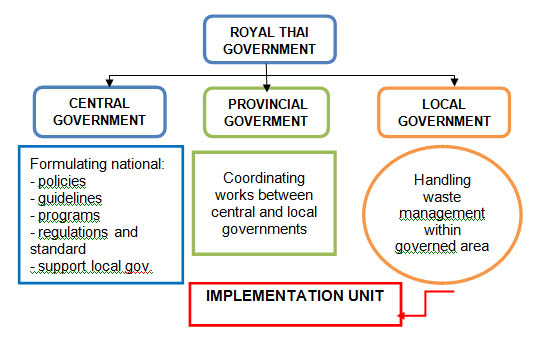 | Figure 1. The Institution and the Relation between Central-Provincial - Local Governments in Waste Management in Thailand |
6. Solid West Management Process in Pattaya City, Thailand
- Solid Waste management in Thailand implementation is under the strong regulation of National Environment policy. In addition, there is a number of legislation related to waste management particularly in identifying and authorizing local governmental agencies as Pattaya city to handle solid waste management at local levels, for example, the Public Health Act B.E.2535 and the Public Cleansing Act B.E.2535. In term of Solid waste management in Pattaya city, Pattaya city local government have full authorities to management but the Policy must follows strictly National or Central government regulations.The local government of Pattaya has full authority in handling solid waste management system within its service area. The central government has the authority to support the solid waste management activities and also creating a certain legal framework for this management system. Pattaya City management Solid waste by unit of waste management under control of Environment bureau, and the bureau is working straightly in Administrators policy and under control of Head of officer, Vice Mayors and Mayors. The process is strong fix legal, long hierarchy and strong control management. This is strong government authorities and strong traditional bureaucratic management as Weber’s theory .This is the Old Public Administration or OPA concept: [2]Pattaya city local government provided solid waste with model of outsourcing. They selected private professional company to provide all of solid waste processing as process of collecting, transporting and disposing. Pattaya city government only controls the quality and process condition contract. In order to undertake the quality of services, Pattaya's Government formulated the condition regulation to private contractor’s management the service process as follows (Pattaya city Solid Waste management TOR 2015-2019): [6]a) Private contractor provides garbage tank to household, communities, market, tourism spot, city economic zone, street, walk way, park and pedestrian. The location for add garbage tank should be convenience, enough and easy to use, and the garbage facilities and garbage point must be a good quality and clean all the time.b) Private contractor transport garbage with the garbage compaction truce to the transfer station and reload to garbage container truce to landfill station every day.c) Disposing general solid waste with landfill proceeding system and for inflection solid waste delivered to inflection garbage disposal factory. d) Contractor investment all in proceeding as design system, land, construction disposal system, preparation material, machine technology and employee, etc.e) Pattaya city local government pay expenditure to private contractors service in rate 1,000 Bath (350,000 IRD) / ton f) Contractor responsible to collect solid waste fee from waste user and sent it to Pattaya City local government.Pattaya's solid waste is services in three basically method, namely (Pattaya city Solid Waste management TOR 2015-2019). [6]1. Collection: Some methods are used for the collection process including: a) Door to Door collection method: Method of door-to-door collecting is for the household solid waste. b) Garbage bulk tank station. The model for collecting solid waste from market and tourist spot is garbage bulk tank station. c) Big container garbage station. Big container garbage station is for activities festival or event waste.2. Transferring and Transporting: Solid waste from city shall transport with compaction truce to landfill station 3. Disposal: Pattaya City use landfill system to disposing waste. This station has 4 landfills in area of 50 Rai (75 acre) constructed under Thailand sanitary standardization. This landfill is received 400-450 ton of Pattaya's solid waste to disposal. Now this landfill is full and cannot receive anymore. Pattaya City is solving the problem by change the place to other landfill location which is far away from Pattaya city.
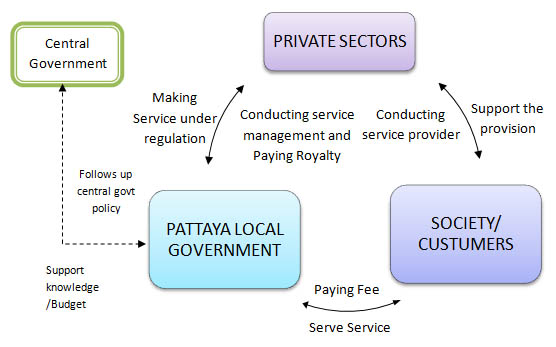 | Figure 2. Existing Model of Solid Waste Management in Pattaya City |
 | Figure 3. Role of Pattaya's Stakeholders in Solid Waste Management |
7. Performance and Risk of Solid Waste Management in Pattaya City
- For all description and data concerning solid waste management process in Pattaya City, it is seen that in the model of management all stakeholders in Pattaya City could enjoy the benefit of services. This model can also maximize the efficiency and effectiveness of public service. Pattaya city could solve its restrictiveness of budget, human resource, and infrastructure in managing issues and can also provide service to the society. Furthermore, the private sector gets the economic or financial benefit by, firstly, receiving the royalty payment from the Pattaya city, and secondly, receiving fund from the result of solid waste procession in solid waste management. While in other side nowadays Pattaya city still facing the amount of Solid Waste continually increase. Pattaya City cannot provide sustainable management to solid waste, sometime it has residual waste in city for example during tourism festival or activity time or landfill system and contractor operations error. We find the cause rise of solid waste management in Pattaya City as follows:
7.1. Lack of Appreciation in Management Planning
- In term of solid waste management, most of system and stakeholder focus on waste management planning, and the number of population is also importance for waste management planning. But In Pattaya City, the number of population is not stable, and it depends on the number of visitors and unregistered population. For example, now the number of registered population in Pattaya about 100,000 person, but the real number of the population including the unregistered and visitor is approximately one million people. So there is not correct real data for do appreciate management planning.
7.2. Bad Behaviour of Tourist and Local People in Loitering Waste
- The big cause of waste problem in the world comes from the number of waste that increasing and the government cannot control it. The basic of waste management concept is how we can decrease waste. In Pattaya City the number of solid waste is continually increase and the cause of it is the human factors. The local people and the tourists do not aware to reduce wastes and do not interest in waste issue. They enjoy to use the things and to loiter the waste. It is common to see that they are loitering waste, do not use in the trash bin, and do not segregates waste into the categorized waste bin. This is among the bad behaviour existed.
7.3. Weakness in Selected Waste Process
- Selecting the waste is an importance action as the basic of decreasing the solid waste amount. Pattaya City local government does not strictly implementing the process. They focus on how they can reach economic growth and visitors enjoy in Pattaya tourism. In solid waste problem, they focus on how they can make city clean and make people satisfy, but does not interest to influence citizen for reducing the waste and managing the solid waste in appropriate system. This is the big cause of fully waste in landfill process at nowadays. Furthermore, there are some private sectors in Pattaya City that selecting waste by themselves because they know that solid waste benefit can return their profit and they have employee to do this activity. In communities and household, the local people does not pay attention in selecting wastes benefit because they are not motivated for doing so and they can make money from other activities rather than waste management.
7.4. Wasting System is not Efficient
- Nowadays, the process for managing solid waste in Pattaya City is not efficient especially the normal system including the collecting, transporting and disposing the garbage. This system is not appropriate to manage waste in big city like Pattaya City. They focus on how they can remove the waste away from the city for keeping the city clean but do not interesting in management solid waste after leaving the city in appropriate system. This is the big cause of fully waste in landfill process at the present time. Now Pattaya does not have alternative process for garbage disposal .They are only looking for the new landfill spot and solve problem day by day. It is not a sustainable idea.
7.5. Lack of the Citizen Participation
- Pattaya City local government has big role and full authority to management waste. All of the process in management is formulating the policy, implementing, and evaluating the implementation by Pattaya City in the strict way. The society and private have little role to participate in the management process. They are the customer in public goods. But in the case of waste problem, government must allow people to participate and share the responsibility like partner, because it is not just public service, but it is about public health.
8. Proposed Model of Pattaya’s Solid Waste Management
- This research argue that the failure of Pattaya City’s solid waste service provision discussed above were mainly caused by the dominant roles that local government authorities play as the only decision-makers of all procedures in the provision of local public services. With no involvement of non-government sectors in decision making of public service provision, the government sectors are unaware of the real needs that service users would like to receive. The government, a principal public service provider, would by no means be aware of overall problems of local public service management. Thus, the current use of the government’s measures to solve problems of the provision of public services, for instance, the ones that aim to help reduce the amount of solid waste or to encourage local service users to follow certain rules or regulations, has received no active response and participation from the citizen. In order to improve solid waste management in Pattaya City, the researcher would like to propose an alternative model. The model requires applications of the citizen participation to provide solid waste service. Local governments do not directly meet all these needs, except in the scope of strategic management, and then the operational aspects handed over to the citizens. The existing NPM practice of Pattaya's solid waste management and the implementation of the so-called quasi-market mechanisms allow the local government authorities to play their roles as decision and policy makers, where as the private sectors’ roles are service providers, while the societies’ or citizens’ roles are public service customers. What Pattaya local government should do is to change the role of societies or citizens from public service customers to public service partner, and invite citizens to participate and involve in all procedures of solid waste management, particularly in the scope of decision making, implementation, and local advocacy. The intention is for providing public services that follow the needs and preferences of citizens by allowing them to run an active role in such provision of public services. Local society should include not only local people, but also local agents, such as private sectors, non-profit organizations, local mass communication and other similar public sectors in Pattaya city area. The researcher has designed a proposed alternative model to the provision of solid waste management in Pattaya City. The model is shown in Figure 4 below.
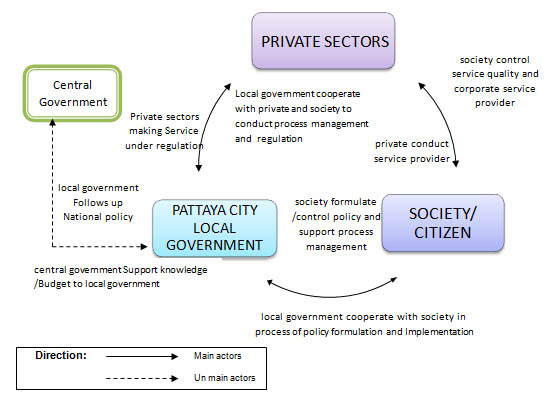 | Figure 4. Recommended Model for Pattaya's Solid Waste Management Procedures |
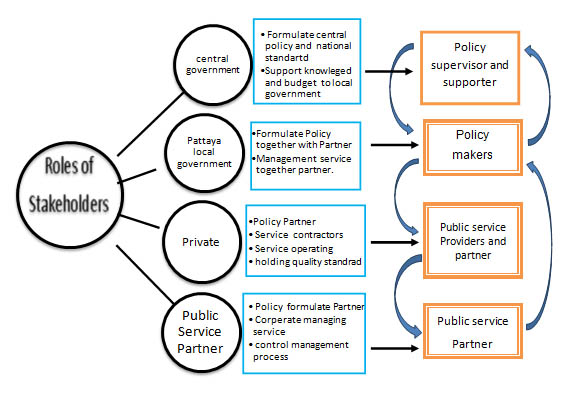 | Figure 5. Recommendations of the Pattaya's Stakeholders’ Roles in Solid Waste Management |
9. Conclusions
- Pattaya City local manages Solid waste by model of outsourcing. They are cooperating with private contractors to provide the service. They tasks only is formulated the policy and provided the necessary support for the implementation as conducted condition, control quality and regulation and expenditure to private contractors. Most of the service tasks are handled by private contractors for systematic. Pattaya's provision Solid waste with 3 basic systems as collecting, transporting, and disposing by landfill, while the citizen (people, owner of hotel, restaurant, etc.) have responsibility only for paying service levy to Pattaya city local government. Thus, the position of the government and private sectors is strong in the process management, and the position of society/citizen is public customer and weak in this process management. Thus it is clear that Pattaya city management solid waste or adopting the idea of quasi-market mechanisms and this is concept model of New Public Management (NPM).The results of this research study, as previously mentioned, demonstrate that Pattaya City were success in making the city clean. However, they have not yet been successful to sustain its solid waste management, and neither have they properly coped with this matter. Due to the rapidly increasing volumes of solid waste generation and accumulation in Pattaya City, the Pattaya local government have already spent large amounts of money to solve this problem. It is likely that more money will be spent to tackle this issue if solid waste in Pattaya City is not carried out in a sufficient and proper manner, and if no efficient and sustainable waste management practices are put into effect. It can be derived the result and give suggestion to Pattaya city local government for developing the system of public service provision in area of solid waste management as follow:1)Model of New Public Management (NPM) is a strong action in role of Pattaya city local government, and Private sectors, but weak action of the local societies/citizen. This model is not appropriate to an efficient management in big tourism city as Pattaya City because it has diversity of local people, tourist, business, communities, needs. The cause of number of Pattay's waste continue increasing is people don't interesting in Pattya's policy to reduce, reuse and recycle , they filing in the roles of customer don't response in the public problem and enjoy to easily use and leave waste. Pattay city local government should be invite and enabling the citizen/societies to participate in Solid waste management process in the scope of decision making, implementation, and local advocacy. The position of society/citizen in this model is not public service customer but it is public service partner.2)In order to achieve genuine progress towards sustainability solid waste management in Pattaya City, it is necessary to implement the concept of sustainable development by proposing and developing targets of a sustainable environment. The implantation of the concept that requires the consideration toward three aspects, namely environment, social, and economics will lead to the creation of solid waste management system that is environmentally sound, economically viable, and socially beneficial. The targets proposed should have clear vision and objectives, devoid of any political agenda or interference. However, from time to time, environmental knowledge and waste management changing, here for, the targets as well as standards need to be modified accordingly. a) Raising public awareness, changing public attitudes and providing education. b) Prevention and Minimization of Waste Management. c) Waste Recycling and Composting. d) Rising Role of Non-government such as Private and Societies. e) Waste integrated management Approach. In planning the Pattaya city solid waste management, a system which considers to the aspects of sustainable development with the least technically complex and most-effective solution should be preferred. In order to achieve the target, an integrated approach may be considered. Integrated thinking for materials and energy recovery are the keys to waste management systems that can shift the waste sector from being the source of environmental problem to becoming the environmental problem solver as suggested by UNEP.
 Abstract
Abstract Reference
Reference Full-Text PDF
Full-Text PDF Full-text HTML
Full-text HTML